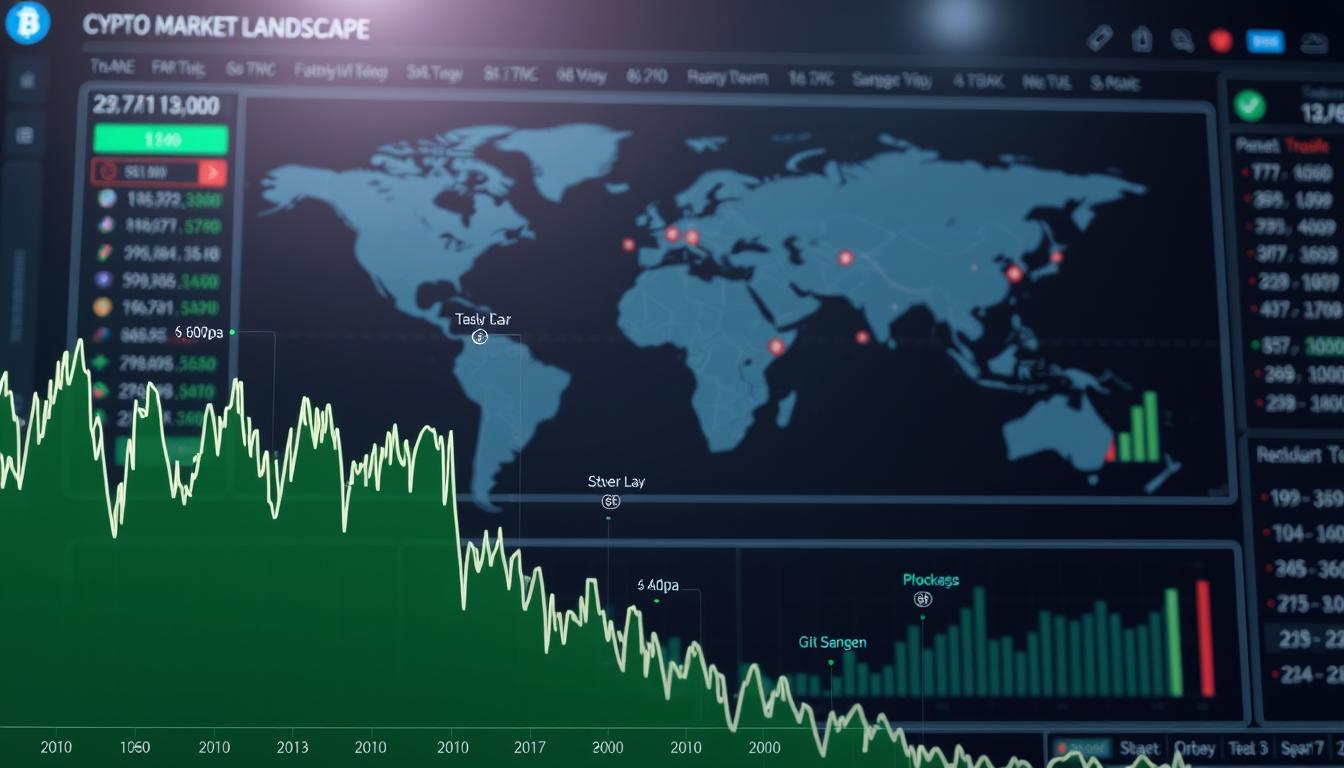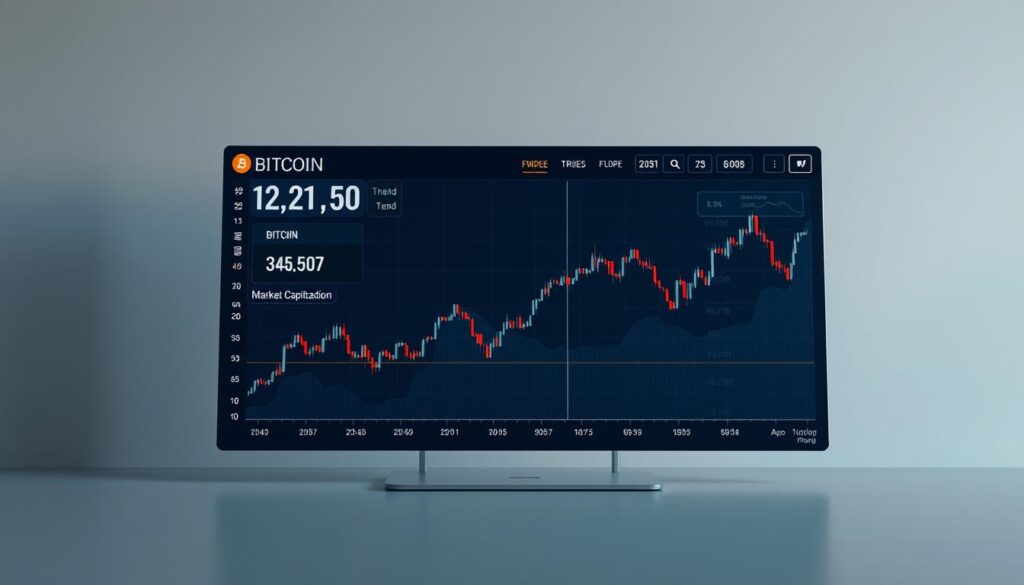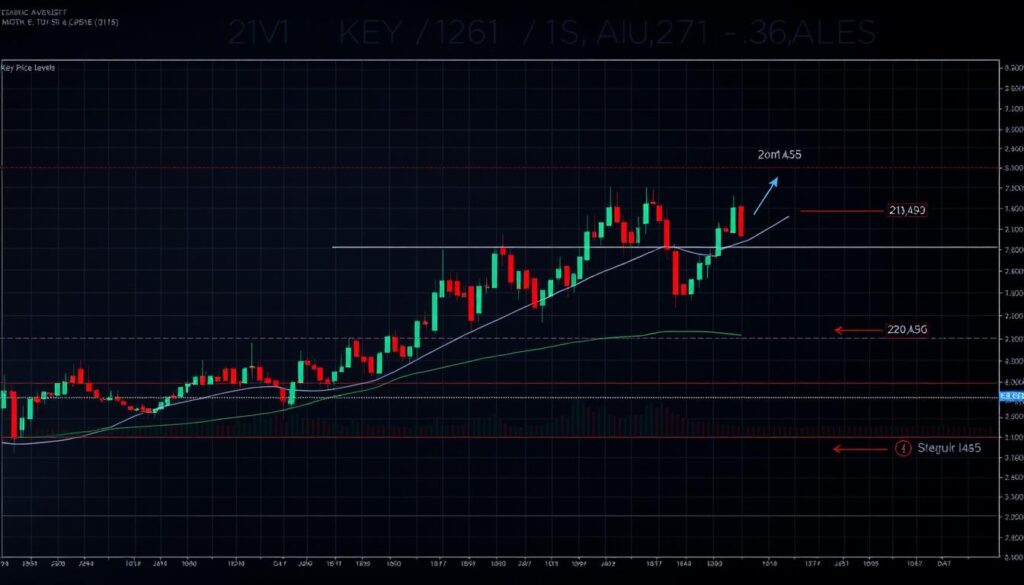Now Reading: Understanding Cryptocurrency Market Analysis and Price Predictions
- 01
Understanding Cryptocurrency Market Analysis and Price Predictions
Understanding Cryptocurrency Market Analysis and Price Predictions

This report sets the scope for a trend review that ties BTC levels, investor behavior, and structure into clear, actionable information for U.S. readers.
We draw on on-chain metrics, derivatives flows, technical chart structure, and macro inputs to frame near-term moves. Current BTC sits near $109,300–$109,367 with a market cap around $2.18T. The Fear & Greed Index reads 33 (Fear), and BTC posted 16 of 30 green days with about 2.3% volatility.
Why BTC? As the benchmark asset, BTC’s shifts shape broader sentiment and portfolio choices. We use intra-day, daily, and weekly lenses to translate signals into disciplined insight.
What to expect: coverage of U.S. inflation policy, ETF flows, derivatives positioning, and how liquidity and sentiment influence short-term probability ranges. Short-term scenarios include possible moves toward $112,302–$115,045 by Sep 29–30, 2025, depending on evolving conditions.
This is informational: it explains directional scenarios and scenario planning rather than offering financial advice. For deeper methods behind price forecasts, see a focused guide on crypto price predictions.
U.S. crypto market snapshot: price, market cap, and prevailing trend
This section anchors the U.S. view with concrete BTC USD figures and a short read on recent direction.

BTC price, market cap, and 7–30 day performance
BTC trades near $109,300–$109,367 USD with a market cap of about $2.18T and ~19,926,800 BTC circulating supply.
Over the last 30 days BTC logged 16 green days (~53%), while the last 7 days show a ~5.68% pullback. That contrast helps frame whether the recent weakness is a short dip or the start of a broader shift.
Volatility and what 16 green days out of 30 tells investors
Roughly 2.3% volatility is low-to-moderate. Sixteen positive days suggest steady participation rather than extreme churn.
Practical takeaways: low-2% swings can mask rotation between assets. Investors should watch breadth and dominance metrics to spot hidden shifts.
- Short-term dip vs. monthly profile: treat a 7-day pullback as part of consolidation unless support breaks.
- Near-term paths to $112,302–$115,045 remain conditional on buyers holding higher lows.
- Liquidity and cap structure influence how fast recoveries stick after drawdowns.
Actionable note: keep a dashboard of data and days-based momentum to avoid overreacting to single-session swings. The next section converts this snapshot into tactical levels and chart structure.
Technical analysis: key levels, moving averages, and chart structure
Key directional levels and moving averages set the tactical map traders watch this week.

Support and resistance: 109,000 acts as the primary defense. A sustained break below that trend line opens the conditional path toward ~62,513, but only if a five-wave C completes.
Immediate ceiling sits at 110,000–112,000. A clean breakout above this band targets 115,000 as the next upside magnet. Moves inside 109k–112k often produce fake-outs; wait for indicator confluence before committing.
Moving average posture
The 4h and daily 50-day moving average are sloping down, creating a short-term bearish bias. The 200-day on those frames is rising, which keeps the intermediate structure mixed.
Weekly bias stays bullish: both weekly 50- and 200-day MAs lie beneath the price. This mismatch can cause whipsaw on shorter timeframes.
Chart context and pattern watch
Bollinger Band Width compression plus a prior triangle as wave 4 sets up for a hotter wave 5 extension. Such extensions can push momentum higher and change how deep subsequent retraces go.
The irregular flat scenario is a 3-3-5 A-B-C. It only becomes actionable toward ~62,500 if a five-wave C appears and key supports fail. That keeps the deep target conditional, not definitive.
Tactical map for BTC management
- Invalidation: close above or below key levels determines bias.
- Trail stops below recent swing lows to protect gains on breakouts.
- Use moving averages, Bollinger Bands, and momentum on the chart to confirm breakouts or breakdowns before scaling positions.
Market sentiment and the Fear & Greed Index
Sentiment indicators show a cautious tilt after a notable leverage washout.

Fear & Greed Index reads 33 (Fear), signaling reduced risk appetite and thinner liquidity on attempts higher.
Fear, positioning, and liquidity
Read 33 as investor caution. This level usually means buyers thin out near resistance while sellers test depth.
Large long liquidations — >$1.5B on September 22, 2025 — cleared excess leverage. That flush raised intraday volatility but also removed crowded bets.
Derivatives washout and entry signals
Post-wipeouts often create cleaner trend setups. Watch for stabilization in open interest and normalized funding before scaling entries.
- Track multi-day follow-through with volume to confirm valid rallies versus noise.
- Use smaller allocations during fearful chop; scale as neutral signals appear.
- Cross-check spot flows with derivative data to filter false positives.
Despite fear-leaning readings, BTC logged 16 green days in 30. This mixed backdrop calls for respect of technical levels while using sentiment as a quality gauge for short-term price moves.
Macro drivers: U.S. inflation, Fed policy, and government funding risks
Higher-than-expected PCE and fiscal uncertainty are shifting how investors discount future returns.

August PCE printed 2.7%, up from 2.6% in July. That single data point strengthens a higher-for-longer Fed narrative and lifts the discount rate used in risky-asset valuation.
When real rates stay elevated, expected price gains must clear a higher hurdle. This raises required risk premia for equities and the crypto market, which can mute rallies even when adoption news is positive.
POTENTIAL SHOCKS: shutdown and liquidity
- A U.S. government funding lapse on Oct 1 could spark a quick sentiment whiplash and reduce liquidity.
- Tighter conditions usually widen basis and spreads, pressuring short-term on-chain activity and derivatives depth.
- Dollar strength often correlates with weaker crypto flows; watch USD moves closely.
What investors should monitor: FOMC guidance shifts, labor prints, PCE/core trends, and funding-deadline headlines. For tactical chart work, see a concise how to analyze crypto charts guide to tie macro to execution.
Institutional flows: Bitcoin ETFs, custody, and adoption signals
Regulated funds and custody upgrades are turning episodic interest into durable demand. Large managers such as BlackRock and Fidelity continue to draw inflows that support medium-term bids for BTC. These channels help institutions hold exposure without direct custody risk.
BlackRock and Fidelity ETF flows as support for medium-term demand
Persistent net creations into bitcoin etfs act as a structural bid. Regular inflows improve spot liquidity and reduce slippage on large orders.
Coinbase CEO’s view: drivers and caveats
Brian Armstrong recently argued that bitcoin could reach $1,000,000 by 2030, citing clearer rules and rising institutional allocation. That thesis hinges on steady inflows, scalable custody, and regulatory continuity; macro cycles or rate moves could alter timelines.
Policy watch: a proposed U.S. strategic reserve fund
A national reserve fund would shift narratives if enacted. Sovereign-level adoption could compress risk premia and support higher sustained USD levels for BTC, but execution risk and political hurdles remain.
| Driver | Impact | Signal |
|---|---|---|
| BlackRock & Fidelity ETF flows | Steadier buy-side liquidity | Net creations, AUM growth |
| Regulated custody & reporting | Lower operational risk for investment mandates | More institutional allocations |
| U.S. reserve fund proposal | Potential sovereign demand, policy tailwind | Legislation, executive orders |
How this feeds scenarios: sustained ETF flows and policy clarity improve the odds of higher USD levels, while weak flows or macro tightening tilt toward slower gains. The following roadmap uses these flows to shape tactical bands.
Cryptocurrency market analysis and price predictions
Focus on a few decisive levels today to turn noise into practical trading steps.
Short-term: defend the 109,000 shelf to keep bulls in control. Holding that support preserves tests of the 110,000–112,000 band. A clean break above that band with volume often opens an extension toward 115,000.
Model runs show possible prints between $112,302 and $124,207 across late September into October 2025. These are conditional ranges; expected ROI varies by entry timing and stop placement.
The Fear & Greed Index at 33 implies relief rallies may be sharp but need confirmation via indicators. Watch momentum re-acceleration above 112k plus breadth improvement as validating signals.
Medium to long-term bands through 2025–2030+ should be treated as scenario corridors rather than point forecasts. The irregular flat downside near ~62,513 remains a non-base case and requires the loss of two rising supports plus a five-wave C for activation.
- Signals to watch: reaction to 109k, sustained move >112k, weekly breadth improvement.
- Time framing: use intraday triggers, then wait for daily closes and weekly confirmation before scaling.
- Use indicator confluence to size risk proportional to volatility.
Bull, base, and bear scenarios for BTC in the months ahead
This section frames three plausible paths for BTC over coming months, tied to ETF flows, macro prints, and key technical triggers.
Bull case
Trigger: steady ETF inflows from major managers plus easing PCE prints.
If buyers reclaim the 110k–112k band with volume, USD levels can extend toward 115k+. Sustained demand would print higher highs and keep momentum intact.
Base case
Trigger: mixed flows and neutral macro data that keep action range-bound.
Expect choppy advance inside 109k–112k, with repeated retests of support and occasional pullbacks. Investors should scale positions slowly and use daily closes to guide sizing.
Bear case
Trigger: loss of rising supports, notably a break below ~109k with confirmation.
A structural failure opens a deeper corrective move, with an example target near ~62,513 if the irregular flat completes. Hedge strategies and reduced exposure help limit downside while the trend resolves.
- Positioning guidance: size positions by scenario confidence; use smaller allocations in base-to-bear transitions.
- Risk reset: repeated rejections at 112k act as invalidation for the bull path and call for stop tightening.
- Psychology: anchor trades to predefined triggers and avoid reacting to headlines.
| Scenario | Catalyst set | Practical step |
|---|---|---|
| Bull | ETF inflows, benign PCE, healthy derivatives | Scale into breakouts; trail stops under rising lows |
| Base | Range acceptance, mixed flows | Use smaller, staged buys; prioritize risk limits |
| Bear | Support loss, liquidity squeeze | Hedge exposure; re-evaluate at weekly support |
Note: this framework is for planning, not individual advice. Year-ahead visibility is limited; update probabilities as new macro prints, ETF flows, and derivatives signals arrive.
Altseason watch: dominance, TOTAL2, and BTC conditions
When BTC trades inside a clear range box, liquidity can rotate into alt tokens quickly. A sideways BTC between two rising supports creates a low-volatility window that has historically allowed TOTAL2 to climb toward all-time highs while BTC dominance rolls lower.
When altcoins fly: sideways BTC, TOTAL2 pushes, and dominance rollover
Classic setup: steady BTC action + a strong bid in TOTAL2 + a downtrend in BTC.D. This trio signals capital shifting into higher-beta assets.
Liquidity rotations and timing exposure with indicators
Watch for breadth expansion, sector breakouts, and rising spot volume outside BTC. Moving-average crossovers on TOTAL2 and momentum re-acceleration often mark risk-on windows.
- Signals to watch: TOTAL2 50/200 MA cross, ETH leading moves, and falling BTC dominance.
- Risk controls: scale entries, tighten stops on volatility spikes, and size by sector conviction.
- Execution notes: USD liquidity and exchange depth matter during fast rotations—slippage can erode gains.
| Condition | Signal | Practical step |
|---|---|---|
| BTC range-bound | Tight ATR, steadier trend | Seed alt positions; watch daily closes |
| TOTAL2 breakout | 50/200 MA crossover, rising volume | Increase exposure to leading sectors |
| BTC.D rollover | Lower highs on dominance chart | Rotate profits from BTC to high-beta tokens |
Keep it holistic: tie altseason signals to macro and sentiment cues from prior sections. If liquidity or risk appetite worsens, rotate back to BTC as dominance stabilizes to protect gains.
Indicator toolkit for traders: building a disciplined approach
A disciplined toolkit turns scattered signals into repeatable trading outcomes.
Moving averages, momentum, and market breadth
Keep rules for moving average signals across timeframes. Treat 4h/daily falling 50-day MAs as caution flags while respecting rising 200-day MAs on higher frames.
Only scale buys when a short-term moving average crosses above a longer one on the same frame or when momentum confirms the move on volume. This prevents overtrading countertrend rallies.
Combine chart patterns with momentum and breadth. Look for pattern breakout + RSI or MACD confirmation and expanding breadth to build higher-probability setups.
Sentiment gauges: Fear & Greed, funding, and open interest
Use a checklist: Fear & Greed at 33, funding normalization, and stable open interest before increasing size. After the $1.5B long washout, wait for funding to calm.
Checklist items:
- Sentiment level within neutral or improving range
- Funding near zero or positive for longs
- Open interest stabilizing with healthy volume
News and on-chain inputs: ETFs, reserves, and macro releases
Predefine how ETF inflows, PCE prints (2.7%), or a funding-deadline shock change your plan. Do not react to headlines without a preplanned scenario.
Verify ETF flow prints and on-chain signals before acting—confirm custodian filings or creation data to maintain information hygiene.
| Signal | Action | Alert threshold |
|---|---|---|
| MA crossover (4h/daily) | Scale position; set tight trail | Short MA > Long MA on same frame |
| Funding normalization | Increase size gradually | Funding near 0 for 24+ hrs |
| ETF net creations confirmed | Bias to longs; check liquidity | Consecutive net creation days |
Investment alignment template: when tactical indicators match the weekly trend, scale; when they diverge, de-risk. Use relative strength scans to pick tokens or assets that lead, not lag.
Finally, run a short post-trade review after each trade. Track which indicators worked and refine thresholds as structure shifts. This closes the loop between scenario planning and execution.
Investment considerations, data notes, and disclaimer
Treat forecasts as planning tools, not guarantees. Use scenarios to prepare actions tied to specific triggers. All references in this report are informational and do not constitute personalized advice or a substitute for professional guidance.
Use cases and limits of forecasts
Examples: a short-term trader may use the 109k support and 110k–112k band for entry and stop rules. A multi-year investor will weigh ETF flows and institutional adoption when sizing long-term exposure.
Forecasts can diverge from outcomes due to macro shocks, liquidity gaps, or model scope limits. For example, a sudden fiscal event or a sharp funding squeeze can invalidate intraday scenarios quickly.
Risk management: sizing, time-in-market, and event risk
Position sizing: cap exposure by volatility—smaller sizes when 2.3% realized swings are present. Use written rules to limit any single position to a fixed share of portfolio assets.
Event risk: plan stop bands around known dates like PCE prints or funding-deadline headlines. Diversify across assets and set exposure caps to reduce drawdowns in adverse regimes.
Data sources, methodology, and interpretation
This report draws on on-chain flows, ETF creation data, funding rates, and technical levels (e.g., 109k support). Scenario bands through late Sep–Oct 2025 reflect model runs and conditional triggers.
Interpret targets using a confidence framework: treat near-term levels as tactical thresholds and multi-year bands as scenario corridors that update year over year as new evidence arrives.
Final disclaimer: this content is for informational purposes only. It is not investment advice. Consult a qualified professional for tailored advice before taking action.
Conclusion
This conclusion pulls the thread of tactical levels, sentiment cues, and flow signals into a clear action map.
Top insights: defend 109k, seek a clean reclaim of 110k–112k to unlock 115k, and respect invalidations before scaling. Use USD benchmarks and watch btc reaction near those zones.
Sentiment (Fear & Greed at 33) and macro news like PCE can steer short-term moves despite constructive weekly trends. Treat ETF inflows from BlackRock and Fidelity as structural support, not a hedge against cyclical drawdowns.
Long-term views — including that bitcoin could reach $1,000,000 by 2030 — remain contingent on regulation, liquidity, and adoption.
Follow the toolkit: combine levels, signals, and tight risk controls. Over time, persistence, process, and patience are the clearest way to navigate volatility in the cryptocurrency market.
FAQ
What does the current U.S. snapshot tell investors about price, market cap, and trend?
The U.S. snapshot highlights overall capitalization, BTC’s price action, and short-term momentum. Look at BTC’s market cap relative to total digital-asset cap to gauge dominance, follow 7–30 day returns to see recent strength, and compare those moves to established trendlines to decide if the market is in a sustained uptrend, consolidation, or correction.
How should I interpret BTC’s 7–30 day performance when making trade decisions?
Short windows help confirm momentum or spot rapid reversals. Consistent gains over 7–30 days suggest buyer conviction, while choppy returns indicate range-bound behavior. Use them with volume, moving averages, and volatility measures to time entries and set tight stops.
What does 16 green days out of 30 imply about volatility and investor behavior?
That ratio signals persistent bullish bias but not an overextended rally by itself. It often reduces near-term volatility but can lure complacency. Combine it with on-chain flows and derivatives data to assess whether strength is backed by fresh demand or short-covering.
Which support and resistance levels should traders watch right now?
Key horizontal levels to monitor are a major support near 109,000, a resistance cluster from 110,000–112,000, and an upside expansion target around 115,000. Price reactions at these zones help determine whether momentum will continue or a retest is likely.
How do multi-timeframe moving averages inform bias when 4‑hour and daily are bearish but weekly is bullish?
Shorter MAs show near-term pressure; the weekly bullish bias means the larger trend still favors upside. Traders often align with the weekly trend while using 4‑hour/daily for lower-risk entries on pullbacks or trend continuation setups.
What is an irregular flat pattern and how could a break of support lead to ~62,500?
An irregular flat is a corrective chart structure with an expanded B wave or deep C wave. If key supports fail, the technical path can unfold toward lower structural targets—around ~62,500 in a conditional scenario—driven by momentum, leverage unwinds, and liquidity gaps.
What does Bollinger compression or triangle formation signal for potential wave 5 extensions?
Compression and triangles indicate reduced volatility and consolidation. A decisive breakout from these patterns often precedes a strong directional move—potentially an extended wave 5—so position sizing and confirmed breakout volume matter for entries.
How should I use the Fear & Greed Index reading of 33 (Fear) for positioning?
A 33 reading signals risk aversion. It often favors cautious positioning: reduced leverage, staggered buys, and focus on defensive stops. Contrarian traders may view it as a selective buying opportunity if other indicators align.
What do large derivatives liquidations, such as aFAQ
What does the current U.S. snapshot tell investors about price, market cap, and trend?
The U.S. snapshot highlights overall capitalization, BTC’s price action, and short-term momentum. Look at BTC’s market cap relative to total digital-asset cap to gauge dominance, follow 7–30 day returns to see recent strength, and compare those moves to established trendlines to decide if the market is in a sustained uptrend, consolidation, or correction.
How should I interpret BTC’s 7–30 day performance when making trade decisions?
Short windows help confirm momentum or spot rapid reversals. Consistent gains over 7–30 days suggest buyer conviction, while choppy returns indicate range-bound behavior. Use them with volume, moving averages, and volatility measures to time entries and set tight stops.
What does 16 green days out of 30 imply about volatility and investor behavior?
That ratio signals persistent bullish bias but not an overextended rally by itself. It often reduces near-term volatility but can lure complacency. Combine it with on-chain flows and derivatives data to assess whether strength is backed by fresh demand or short-covering.
Which support and resistance levels should traders watch right now?
Key horizontal levels to monitor are a major support near 109,000, a resistance cluster from 110,000–112,000, and an upside expansion target around 115,000. Price reactions at these zones help determine whether momentum will continue or a retest is likely.
How do multi-timeframe moving averages inform bias when 4‑hour and daily are bearish but weekly is bullish?
Shorter MAs show near-term pressure; the weekly bullish bias means the larger trend still favors upside. Traders often align with the weekly trend while using 4‑hour/daily for lower-risk entries on pullbacks or trend continuation setups.
What is an irregular flat pattern and how could a break of support lead to ~62,500?
An irregular flat is a corrective chart structure with an expanded B wave or deep C wave. If key supports fail, the technical path can unfold toward lower structural targets—around ~62,500 in a conditional scenario—driven by momentum, leverage unwinds, and liquidity gaps.
What does Bollinger compression or triangle formation signal for potential wave 5 extensions?
Compression and triangles indicate reduced volatility and consolidation. A decisive breakout from these patterns often precedes a strong directional move—potentially an extended wave 5—so position sizing and confirmed breakout volume matter for entries.
How should I use the Fear & Greed Index reading of 33 (Fear) for positioning?
A 33 reading signals risk aversion. It often favors cautious positioning: reduced leverage, staggered buys, and focus on defensive stops. Contrarian traders may view it as a selective buying opportunity if other indicators align.
What do large derivatives liquidations, such as a $1.5B long washout, mean for entry timing?
Big long liquidations remove leveraged buying pressure and can create short-term price stress. After washouts, liquidity often returns and provides cleaner entries for disciplined buyers if fundamental flows remain supportive.
How do U.S. macro drivers like PCE at 2.7% affect risk premia for digital assets?
A 2.7% PCE reading influences Fed rate expectations. Lower inflation or a dovish rate path reduces risk premia, supporting higher risk-asset valuations. Conversely, surprise inflation raises rates and compresses risk appetite, pressuring prices.
How could a U.S. government shutdown impact sentiment and prices?
A shutdown can trigger risk-off flows, reduce liquidity, and briefly hurt risk assets. Markets may price in higher uncertainty until funding resumes, producing whipsaw moves that traders should hedge or reduce exposure against.
What role do institutional flows from ETFs and custody services play in medium-term demand?
ETF inflows and secure custody by large firms create structural demand, reduce available supply, and attract long-term capital. Consistent inflows from providers like BlackRock and Fidelity tend to support higher base valuation over months to quarters.
What are the caveats around bullish statements such as Bitcoin reaching $1 million by 2030?
Bold price targets reflect long-term adoption views but depend on macro trends, regulatory outcomes, and capital flows. Treat such forecasts as scenario-driven — not guaranteed — and manage position size around uncertainty.
How might a proposed U.S. strategic Bitcoin reserve fund act as a market catalyst?
A strategic reserve could materially tighten supply and signal official demand, boosting confidence and institutional participation. The impact depends on mandate size, purchase cadence, and legal framework.
What is the short-term roadmap if 109k holds versus a break of 110k–112k?
If 109k holds, expect consolidation and potential re-tests of the 110k–112k cluster. A clean break above that range increases odds of an extension toward 115k. A failure below 109k opens the path to deeper corrective targets.
What near-term ranges should traders monitor for September–October projections?
Monitor the established support and resistance bands for intra-month swings. Prepare for ROI scenarios by mapping entries near support and trimming into resistance, while using volatility-based stops.
What are the medium-to-long-term scenario bands (2025–2030+) traders should consider?
Use scenario ranges: bullish expansion driven by adoption and ETFs, base case with sideways advancement and periodic retests, and a bear case from macro shocks. Frame portfolios with time-horizon buckets to match these outcomes.
What drives a true altseason and how do BTC conditions affect altcoin performance?
Altcoins often rally when BTC is range-bound or weakening slightly, TOTAL2 starts to rise, and BTC dominance rolls over. Liquidity rotations from BTC into altcoins, combined with favorable macro flows, power altseason moves.
How can investors time exposure during liquidity rotations between BTC and altcoins?
Watch on-chain flow, open interest shifts, and market breadth. Enter alts selectively when BTC stabilizes and TOTAL2 shows breakout attempts, using smaller position sizes and tight risk controls.
Which indicators form a reliable trader toolkit for disciplined decisions?
Combine moving averages across timeframes, momentum indicators, and breadth metrics. Add sentiment gauges like Fear & Greed, funding rates, and open interest, plus news and on-chain inputs such as ETF flows and reserve changes.
How should investors treat forecasts and what risk management practices are recommended?
Treat forecasts as probabilistic scenarios, not certainties. Use position sizing, stop-loss rules, and time-in-market diversification. Stress-test portfolios for event risk and never rely on a single indicator for decisions.
What data sources and methodology should readers prefer when evaluating projections?
Favor transparent, verifiable sources: exchange data, custody reports, ETF filings, macro releases, and reputable on-chain analytics. Understand model assumptions, time horizons, and sensitivity to key inputs before acting.
What does the current U.S. snapshot tell investors about price, market cap, and trend?
The U.S. snapshot highlights overall capitalization, BTC’s price action, and short-term momentum. Look at BTC’s market cap relative to total digital-asset cap to gauge dominance, follow 7–30 day returns to see recent strength, and compare those moves to established trendlines to decide if the market is in a sustained uptrend, consolidation, or correction.
How should I interpret BTC’s 7–30 day performance when making trade decisions?
Short windows help confirm momentum or spot rapid reversals. Consistent gains over 7–30 days suggest buyer conviction, while choppy returns indicate range-bound behavior. Use them with volume, moving averages, and volatility measures to time entries and set tight stops.
What does 16 green days out of 30 imply about volatility and investor behavior?
That ratio signals persistent bullish bias but not an overextended rally by itself. It often reduces near-term volatility but can lure complacency. Combine it with on-chain flows and derivatives data to assess whether strength is backed by fresh demand or short-covering.
Which support and resistance levels should traders watch right now?
Key horizontal levels to monitor are a major support near 109,000, a resistance cluster from 110,000–112,000, and an upside expansion target around 115,000. Price reactions at these zones help determine whether momentum will continue or a retest is likely.
How do multi-timeframe moving averages inform bias when 4‑hour and daily are bearish but weekly is bullish?
Shorter MAs show near-term pressure; the weekly bullish bias means the larger trend still favors upside. Traders often align with the weekly trend while using 4‑hour/daily for lower-risk entries on pullbacks or trend continuation setups.
What is an irregular flat pattern and how could a break of support lead to ~62,500?
An irregular flat is a corrective chart structure with an expanded B wave or deep C wave. If key supports fail, the technical path can unfold toward lower structural targets—around ~62,500 in a conditional scenario—driven by momentum, leverage unwinds, and liquidity gaps.
What does Bollinger compression or triangle formation signal for potential wave 5 extensions?
Compression and triangles indicate reduced volatility and consolidation. A decisive breakout from these patterns often precedes a strong directional move—potentially an extended wave 5—so position sizing and confirmed breakout volume matter for entries.
How should I use the Fear & Greed Index reading of 33 (Fear) for positioning?
A 33 reading signals risk aversion. It often favors cautious positioning: reduced leverage, staggered buys, and focus on defensive stops. Contrarian traders may view it as a selective buying opportunity if other indicators align.
What do large derivatives liquidations, such as a $1.5B long washout, mean for entry timing?
Big long liquidations remove leveraged buying pressure and can create short-term price stress. After washouts, liquidity often returns and provides cleaner entries for disciplined buyers if fundamental flows remain supportive.
How do U.S. macro drivers like PCE at 2.7% affect risk premia for digital assets?
A 2.7% PCE reading influences Fed rate expectations. Lower inflation or a dovish rate path reduces risk premia, supporting higher risk-asset valuations. Conversely, surprise inflation raises rates and compresses risk appetite, pressuring prices.
How could a U.S. government shutdown impact sentiment and prices?
A shutdown can trigger risk-off flows, reduce liquidity, and briefly hurt risk assets. Markets may price in higher uncertainty until funding resumes, producing whipsaw moves that traders should hedge or reduce exposure against.
What role do institutional flows from ETFs and custody services play in medium-term demand?
ETF inflows and secure custody by large firms create structural demand, reduce available supply, and attract long-term capital. Consistent inflows from providers like BlackRock and Fidelity tend to support higher base valuation over months to quarters.
What are the caveats around bullish statements such as Bitcoin reaching $1 million by 2030?
Bold price targets reflect long-term adoption views but depend on macro trends, regulatory outcomes, and capital flows. Treat such forecasts as scenario-driven — not guaranteed — and manage position size around uncertainty.
How might a proposed U.S. strategic Bitcoin reserve fund act as a market catalyst?
A strategic reserve could materially tighten supply and signal official demand, boosting confidence and institutional participation. The impact depends on mandate size, purchase cadence, and legal framework.
What is the short-term roadmap if 109k holds versus a break of 110k–112k?
If 109k holds, expect consolidation and potential re-tests of the 110k–112k cluster. A clean break above that range increases odds of an extension toward 115k. A failure below 109k opens the path to deeper corrective targets.
What near-term ranges should traders monitor for September–October projections?
Monitor the established support and resistance bands for intra-month swings. Prepare for ROI scenarios by mapping entries near support and trimming into resistance, while using volatility-based stops.
What are the medium-to-long-term scenario bands (2025–2030+) traders should consider?
Use scenario ranges: bullish expansion driven by adoption and ETFs, base case with sideways advancement and periodic retests, and a bear case from macro shocks. Frame portfolios with time-horizon buckets to match these outcomes.
What drives a true altseason and how do BTC conditions affect altcoin performance?
Altcoins often rally when BTC is range-bound or weakening slightly, TOTAL2 starts to rise, and BTC dominance rolls over. Liquidity rotations from BTC into altcoins, combined with favorable macro flows, power altseason moves.
How can investors time exposure during liquidity rotations between BTC and altcoins?
Watch on-chain flow, open interest shifts, and market breadth. Enter alts selectively when BTC stabilizes and TOTAL2 shows breakout attempts, using smaller position sizes and tight risk controls.
Which indicators form a reliable trader toolkit for disciplined decisions?
Combine moving averages across timeframes, momentum indicators, and breadth metrics. Add sentiment gauges like Fear & Greed, funding rates, and open interest, plus news and on-chain inputs such as ETF flows and reserve changes.
How should investors treat forecasts and what risk management practices are recommended?
Treat forecasts as probabilistic scenarios, not certainties. Use position sizing, stop-loss rules, and time-in-market diversification. Stress-test portfolios for event risk and never rely on a single indicator for decisions.
What data sources and methodology should readers prefer when evaluating projections?
Favor transparent, verifiable sources: exchange data, custody reports, ETF filings, macro releases, and reputable on-chain analytics. Understand model assumptions, time horizons, and sensitivity to key inputs before acting.
.5B long washout, mean for entry timing?
Big long liquidations remove leveraged buying pressure and can create short-term price stress. After washouts, liquidity often returns and provides cleaner entries for disciplined buyers if fundamental flows remain supportive.
How do U.S. macro drivers like PCE at 2.7% affect risk premia for digital assets?
A 2.7% PCE reading influences Fed rate expectations. Lower inflation or a dovish rate path reduces risk premia, supporting higher risk-asset valuations. Conversely, surprise inflation raises rates and compresses risk appetite, pressuring prices.
How could a U.S. government shutdown impact sentiment and prices?
A shutdown can trigger risk-off flows, reduce liquidity, and briefly hurt risk assets. Markets may price in higher uncertainty until funding resumes, producing whipsaw moves that traders should hedge or reduce exposure against.
What role do institutional flows from ETFs and custody services play in medium-term demand?
ETF inflows and secure custody by large firms create structural demand, reduce available supply, and attract long-term capital. Consistent inflows from providers like BlackRock and Fidelity tend to support higher base valuation over months to quarters.
What are the caveats around bullish statements such as Bitcoin reachingFAQ
What does the current U.S. snapshot tell investors about price, market cap, and trend?
The U.S. snapshot highlights overall capitalization, BTC’s price action, and short-term momentum. Look at BTC’s market cap relative to total digital-asset cap to gauge dominance, follow 7–30 day returns to see recent strength, and compare those moves to established trendlines to decide if the market is in a sustained uptrend, consolidation, or correction.
How should I interpret BTC’s 7–30 day performance when making trade decisions?
Short windows help confirm momentum or spot rapid reversals. Consistent gains over 7–30 days suggest buyer conviction, while choppy returns indicate range-bound behavior. Use them with volume, moving averages, and volatility measures to time entries and set tight stops.
What does 16 green days out of 30 imply about volatility and investor behavior?
That ratio signals persistent bullish bias but not an overextended rally by itself. It often reduces near-term volatility but can lure complacency. Combine it with on-chain flows and derivatives data to assess whether strength is backed by fresh demand or short-covering.
Which support and resistance levels should traders watch right now?
Key horizontal levels to monitor are a major support near 109,000, a resistance cluster from 110,000–112,000, and an upside expansion target around 115,000. Price reactions at these zones help determine whether momentum will continue or a retest is likely.
How do multi-timeframe moving averages inform bias when 4‑hour and daily are bearish but weekly is bullish?
Shorter MAs show near-term pressure; the weekly bullish bias means the larger trend still favors upside. Traders often align with the weekly trend while using 4‑hour/daily for lower-risk entries on pullbacks or trend continuation setups.
What is an irregular flat pattern and how could a break of support lead to ~62,500?
An irregular flat is a corrective chart structure with an expanded B wave or deep C wave. If key supports fail, the technical path can unfold toward lower structural targets—around ~62,500 in a conditional scenario—driven by momentum, leverage unwinds, and liquidity gaps.
What does Bollinger compression or triangle formation signal for potential wave 5 extensions?
Compression and triangles indicate reduced volatility and consolidation. A decisive breakout from these patterns often precedes a strong directional move—potentially an extended wave 5—so position sizing and confirmed breakout volume matter for entries.
How should I use the Fear & Greed Index reading of 33 (Fear) for positioning?
A 33 reading signals risk aversion. It often favors cautious positioning: reduced leverage, staggered buys, and focus on defensive stops. Contrarian traders may view it as a selective buying opportunity if other indicators align.
What do large derivatives liquidations, such as a $1.5B long washout, mean for entry timing?
Big long liquidations remove leveraged buying pressure and can create short-term price stress. After washouts, liquidity often returns and provides cleaner entries for disciplined buyers if fundamental flows remain supportive.
How do U.S. macro drivers like PCE at 2.7% affect risk premia for digital assets?
A 2.7% PCE reading influences Fed rate expectations. Lower inflation or a dovish rate path reduces risk premia, supporting higher risk-asset valuations. Conversely, surprise inflation raises rates and compresses risk appetite, pressuring prices.
How could a U.S. government shutdown impact sentiment and prices?
A shutdown can trigger risk-off flows, reduce liquidity, and briefly hurt risk assets. Markets may price in higher uncertainty until funding resumes, producing whipsaw moves that traders should hedge or reduce exposure against.
What role do institutional flows from ETFs and custody services play in medium-term demand?
ETF inflows and secure custody by large firms create structural demand, reduce available supply, and attract long-term capital. Consistent inflows from providers like BlackRock and Fidelity tend to support higher base valuation over months to quarters.
What are the caveats around bullish statements such as Bitcoin reaching $1 million by 2030?
Bold price targets reflect long-term adoption views but depend on macro trends, regulatory outcomes, and capital flows. Treat such forecasts as scenario-driven — not guaranteed — and manage position size around uncertainty.
How might a proposed U.S. strategic Bitcoin reserve fund act as a market catalyst?
A strategic reserve could materially tighten supply and signal official demand, boosting confidence and institutional participation. The impact depends on mandate size, purchase cadence, and legal framework.
What is the short-term roadmap if 109k holds versus a break of 110k–112k?
If 109k holds, expect consolidation and potential re-tests of the 110k–112k cluster. A clean break above that range increases odds of an extension toward 115k. A failure below 109k opens the path to deeper corrective targets.
What near-term ranges should traders monitor for September–October projections?
Monitor the established support and resistance bands for intra-month swings. Prepare for ROI scenarios by mapping entries near support and trimming into resistance, while using volatility-based stops.
What are the medium-to-long-term scenario bands (2025–2030+) traders should consider?
Use scenario ranges: bullish expansion driven by adoption and ETFs, base case with sideways advancement and periodic retests, and a bear case from macro shocks. Frame portfolios with time-horizon buckets to match these outcomes.
What drives a true altseason and how do BTC conditions affect altcoin performance?
Altcoins often rally when BTC is range-bound or weakening slightly, TOTAL2 starts to rise, and BTC dominance rolls over. Liquidity rotations from BTC into altcoins, combined with favorable macro flows, power altseason moves.
How can investors time exposure during liquidity rotations between BTC and altcoins?
Watch on-chain flow, open interest shifts, and market breadth. Enter alts selectively when BTC stabilizes and TOTAL2 shows breakout attempts, using smaller position sizes and tight risk controls.
Which indicators form a reliable trader toolkit for disciplined decisions?
Combine moving averages across timeframes, momentum indicators, and breadth metrics. Add sentiment gauges like Fear & Greed, funding rates, and open interest, plus news and on-chain inputs such as ETF flows and reserve changes.
How should investors treat forecasts and what risk management practices are recommended?
Treat forecasts as probabilistic scenarios, not certainties. Use position sizing, stop-loss rules, and time-in-market diversification. Stress-test portfolios for event risk and never rely on a single indicator for decisions.
What data sources and methodology should readers prefer when evaluating projections?
Favor transparent, verifiable sources: exchange data, custody reports, ETF filings, macro releases, and reputable on-chain analytics. Understand model assumptions, time horizons, and sensitivity to key inputs before acting.
What does the current U.S. snapshot tell investors about price, market cap, and trend?
The U.S. snapshot highlights overall capitalization, BTC’s price action, and short-term momentum. Look at BTC’s market cap relative to total digital-asset cap to gauge dominance, follow 7–30 day returns to see recent strength, and compare those moves to established trendlines to decide if the market is in a sustained uptrend, consolidation, or correction.
How should I interpret BTC’s 7–30 day performance when making trade decisions?
Short windows help confirm momentum or spot rapid reversals. Consistent gains over 7–30 days suggest buyer conviction, while choppy returns indicate range-bound behavior. Use them with volume, moving averages, and volatility measures to time entries and set tight stops.
What does 16 green days out of 30 imply about volatility and investor behavior?
That ratio signals persistent bullish bias but not an overextended rally by itself. It often reduces near-term volatility but can lure complacency. Combine it with on-chain flows and derivatives data to assess whether strength is backed by fresh demand or short-covering.
Which support and resistance levels should traders watch right now?
Key horizontal levels to monitor are a major support near 109,000, a resistance cluster from 110,000–112,000, and an upside expansion target around 115,000. Price reactions at these zones help determine whether momentum will continue or a retest is likely.
How do multi-timeframe moving averages inform bias when 4‑hour and daily are bearish but weekly is bullish?
Shorter MAs show near-term pressure; the weekly bullish bias means the larger trend still favors upside. Traders often align with the weekly trend while using 4‑hour/daily for lower-risk entries on pullbacks or trend continuation setups.
What is an irregular flat pattern and how could a break of support lead to ~62,500?
An irregular flat is a corrective chart structure with an expanded B wave or deep C wave. If key supports fail, the technical path can unfold toward lower structural targets—around ~62,500 in a conditional scenario—driven by momentum, leverage unwinds, and liquidity gaps.
What does Bollinger compression or triangle formation signal for potential wave 5 extensions?
Compression and triangles indicate reduced volatility and consolidation. A decisive breakout from these patterns often precedes a strong directional move—potentially an extended wave 5—so position sizing and confirmed breakout volume matter for entries.
How should I use the Fear & Greed Index reading of 33 (Fear) for positioning?
A 33 reading signals risk aversion. It often favors cautious positioning: reduced leverage, staggered buys, and focus on defensive stops. Contrarian traders may view it as a selective buying opportunity if other indicators align.
What do large derivatives liquidations, such as a $1.5B long washout, mean for entry timing?
Big long liquidations remove leveraged buying pressure and can create short-term price stress. After washouts, liquidity often returns and provides cleaner entries for disciplined buyers if fundamental flows remain supportive.
How do U.S. macro drivers like PCE at 2.7% affect risk premia for digital assets?
A 2.7% PCE reading influences Fed rate expectations. Lower inflation or a dovish rate path reduces risk premia, supporting higher risk-asset valuations. Conversely, surprise inflation raises rates and compresses risk appetite, pressuring prices.
How could a U.S. government shutdown impact sentiment and prices?
A shutdown can trigger risk-off flows, reduce liquidity, and briefly hurt risk assets. Markets may price in higher uncertainty until funding resumes, producing whipsaw moves that traders should hedge or reduce exposure against.
What role do institutional flows from ETFs and custody services play in medium-term demand?
ETF inflows and secure custody by large firms create structural demand, reduce available supply, and attract long-term capital. Consistent inflows from providers like BlackRock and Fidelity tend to support higher base valuation over months to quarters.
What are the caveats around bullish statements such as Bitcoin reaching $1 million by 2030?
Bold price targets reflect long-term adoption views but depend on macro trends, regulatory outcomes, and capital flows. Treat such forecasts as scenario-driven — not guaranteed — and manage position size around uncertainty.
How might a proposed U.S. strategic Bitcoin reserve fund act as a market catalyst?
A strategic reserve could materially tighten supply and signal official demand, boosting confidence and institutional participation. The impact depends on mandate size, purchase cadence, and legal framework.
What is the short-term roadmap if 109k holds versus a break of 110k–112k?
If 109k holds, expect consolidation and potential re-tests of the 110k–112k cluster. A clean break above that range increases odds of an extension toward 115k. A failure below 109k opens the path to deeper corrective targets.
What near-term ranges should traders monitor for September–October projections?
Monitor the established support and resistance bands for intra-month swings. Prepare for ROI scenarios by mapping entries near support and trimming into resistance, while using volatility-based stops.
What are the medium-to-long-term scenario bands (2025–2030+) traders should consider?
Use scenario ranges: bullish expansion driven by adoption and ETFs, base case with sideways advancement and periodic retests, and a bear case from macro shocks. Frame portfolios with time-horizon buckets to match these outcomes.
What drives a true altseason and how do BTC conditions affect altcoin performance?
Altcoins often rally when BTC is range-bound or weakening slightly, TOTAL2 starts to rise, and BTC dominance rolls over. Liquidity rotations from BTC into altcoins, combined with favorable macro flows, power altseason moves.
How can investors time exposure during liquidity rotations between BTC and altcoins?
Watch on-chain flow, open interest shifts, and market breadth. Enter alts selectively when BTC stabilizes and TOTAL2 shows breakout attempts, using smaller position sizes and tight risk controls.
Which indicators form a reliable trader toolkit for disciplined decisions?
Combine moving averages across timeframes, momentum indicators, and breadth metrics. Add sentiment gauges like Fear & Greed, funding rates, and open interest, plus news and on-chain inputs such as ETF flows and reserve changes.
How should investors treat forecasts and what risk management practices are recommended?
Treat forecasts as probabilistic scenarios, not certainties. Use position sizing, stop-loss rules, and time-in-market diversification. Stress-test portfolios for event risk and never rely on a single indicator for decisions.
What data sources and methodology should readers prefer when evaluating projections?
Favor transparent, verifiable sources: exchange data, custody reports, ETF filings, macro releases, and reputable on-chain analytics. Understand model assumptions, time horizons, and sensitivity to key inputs before acting.
million by 2030?
Bold price targets reflect long-term adoption views but depend on macro trends, regulatory outcomes, and capital flows. Treat such forecasts as scenario-driven — not guaranteed — and manage position size around uncertainty.
How might a proposed U.S. strategic Bitcoin reserve fund act as a market catalyst?
A strategic reserve could materially tighten supply and signal official demand, boosting confidence and institutional participation. The impact depends on mandate size, purchase cadence, and legal framework.
What is the short-term roadmap if 109k holds versus a break of 110k–112k?
If 109k holds, expect consolidation and potential re-tests of the 110k–112k cluster. A clean break above that range increases odds of an extension toward 115k. A failure below 109k opens the path to deeper corrective targets.
What near-term ranges should traders monitor for September–October projections?
Monitor the established support and resistance bands for intra-month swings. Prepare for ROI scenarios by mapping entries near support and trimming into resistance, while using volatility-based stops.
What are the medium-to-long-term scenario bands (2025–2030+) traders should consider?
Use scenario ranges: bullish expansion driven by adoption and ETFs, base case with sideways advancement and periodic retests, and a bear case from macro shocks. Frame portfolios with time-horizon buckets to match these outcomes.
What drives a true altseason and how do BTC conditions affect altcoin performance?
Altcoins often rally when BTC is range-bound or weakening slightly, TOTAL2 starts to rise, and BTC dominance rolls over. Liquidity rotations from BTC into altcoins, combined with favorable macro flows, power altseason moves.
How can investors time exposure during liquidity rotations between BTC and altcoins?
Watch on-chain flow, open interest shifts, and market breadth. Enter alts selectively when BTC stabilizes and TOTAL2 shows breakout attempts, using smaller position sizes and tight risk controls.
Which indicators form a reliable trader toolkit for disciplined decisions?
Combine moving averages across timeframes, momentum indicators, and breadth metrics. Add sentiment gauges like Fear & Greed, funding rates, and open interest, plus news and on-chain inputs such as ETF flows and reserve changes.
How should investors treat forecasts and what risk management practices are recommended?
Treat forecasts as probabilistic scenarios, not certainties. Use position sizing, stop-loss rules, and time-in-market diversification. Stress-test portfolios for event risk and never rely on a single indicator for decisions.
What data sources and methodology should readers prefer when evaluating projections?
Favor transparent, verifiable sources: exchange data, custody reports, ETF filings, macro releases, and reputable on-chain analytics. Understand model assumptions, time horizons, and sensitivity to key inputs before acting.














